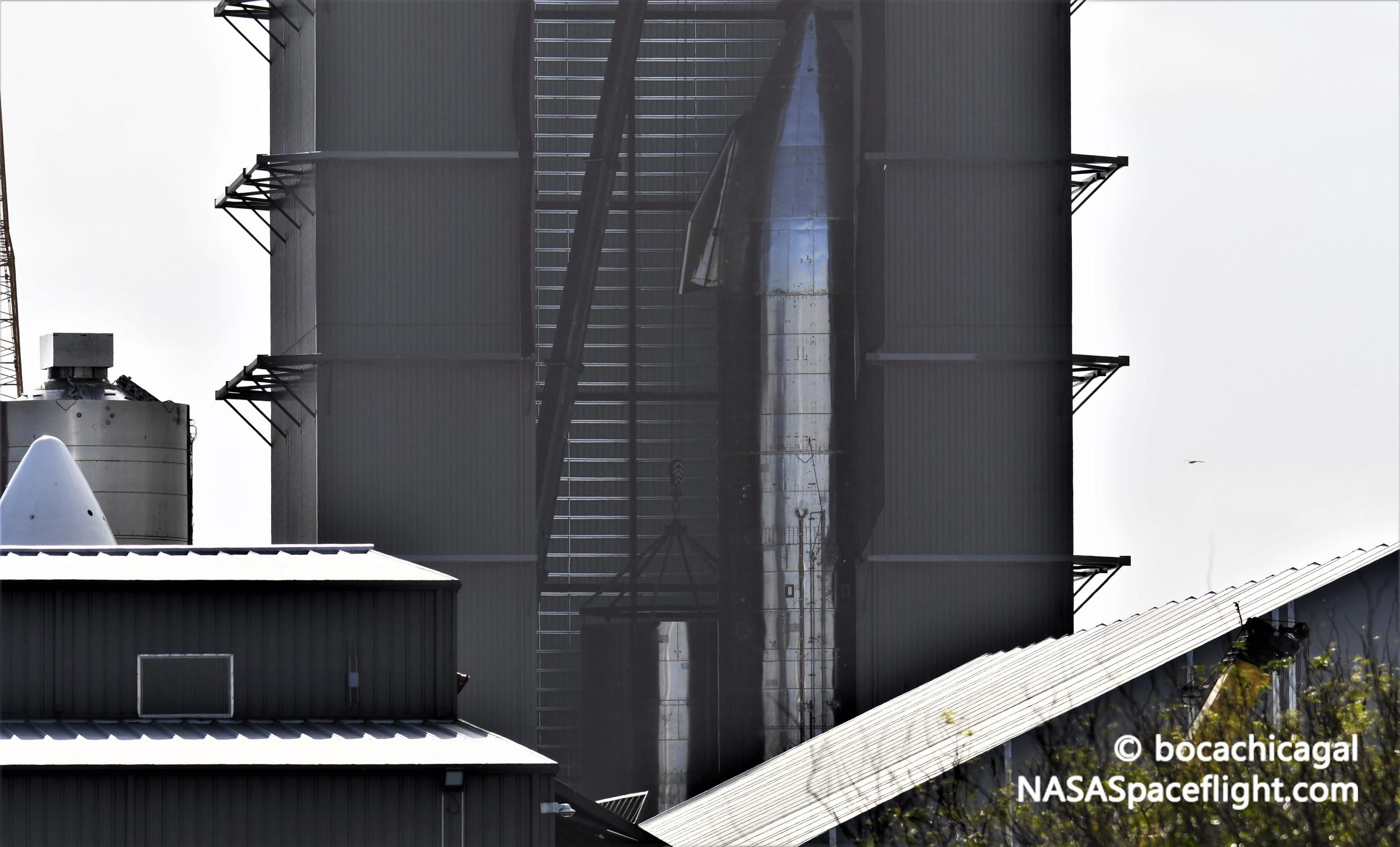

News
SpaceX’s second Super Heavy booster enters production in South Texas
In a rare burst of visible activity, SpaceX’s South Texas Starship factory has begun fabricating a second Super Heavy booster and taken a significant step forward on the first prototype.
Set to be the largest operational rocket stage ever built by more than a factor of two, Super Heavy is the booster tasked with launching a fully fueled and loaded Starship (~1400 mT or 3 million lbs) out of the bulk of Earth’s atmosphere. Powered by up to 28 Raptor engines, Super Heavy and Starship will weigh upwards of 5000 metric tons (~11 million lbs) and produce anywhere from 5600 to 7700 metric tons (12.5-17 million lbf) of thrust at liftoff.
Most importantly, though SpaceX CEO Elon Musk has noted that an optimized Starship might be able to reach orbit on a one-way trip, a giant, reasonably efficient booster like Super Heavy is necessary to send Starship into a healthy orbit with all the extra hardware and mass needed to make the orbital spaceship reusable. More than twice as heavy and two-thirds as tall as SpaceX’s workhorse Falcon 9 rocket, that will be no small feat.
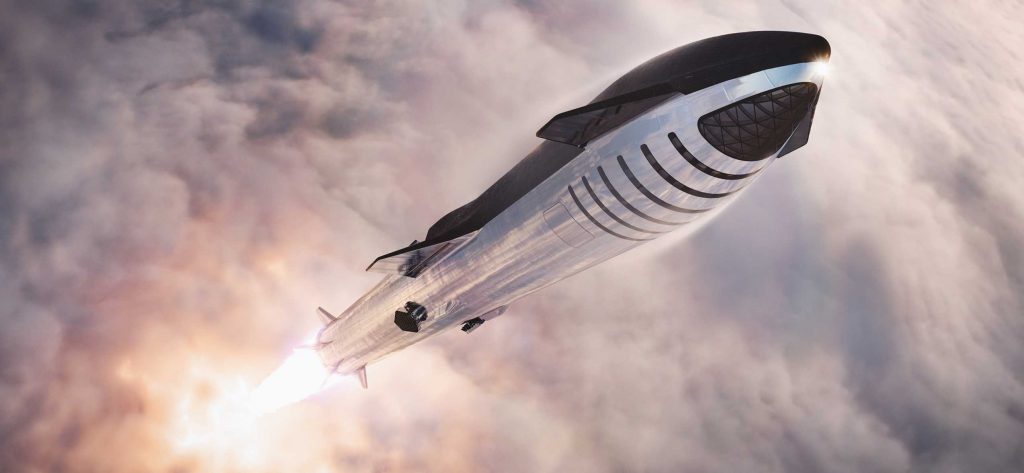
Following the appearance of Super Heavy booster number 1’s (BN1) unique common dome, extra-large ‘transfer tube’ segments, and a donut-like eight-Raptor thrust section last month, visible booster work settled down for the next several weeks. In the interim, Musk revealed that SpaceX aims to hop the first Super Heavy booster (BN1) just “a few months” into 2021, followed by the bombshell that the CEO wants to eventually catch Super Heavy boosters to avoid the need for landing legs entirely.
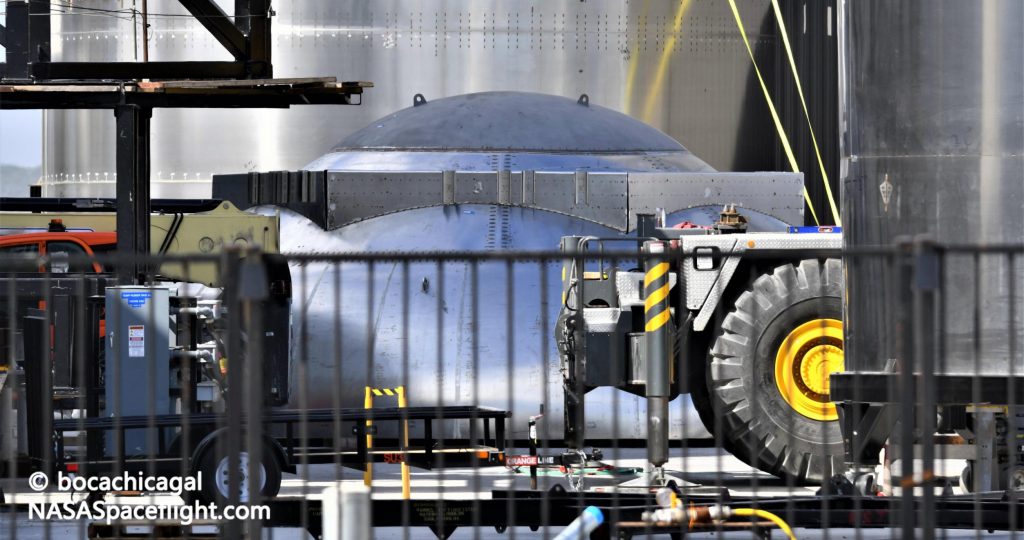
Two weeks after that latest info from Musk and a month after major booster-related factory activity, the first hardware intended for Super Heavy prototype BN2 was spotted on January 19th. Featuring a never-before-seen structural addition in the form of what looks like a hexagonal or octagonal steel ring, the booster’s unique forward dome represents the first real evidence of the modifications needed to install a variety of hardware specific to Super Heavy.
The limited nature and number of current views make it hard to conclude with certainty that the BN2 forward dome’s add-on is hexagonal or octagonal – either could technically be made to work. Barring a surprise design change, Super Heavy – like Falcon 9 and Heavy boosters – will sport four equally spaced grid fins and use them to ensure aerodynamic stability and control authority from hypersonic to supersonic velocities. Based on official SpaceX graphics, Super Heavy’s grid fins will be built out of welded steel, measure some 7 meters (23 ft) tall, and likely weigh 5+ metric tons apiece, thus requiring extremely powerful actuation systems and strong structural support.
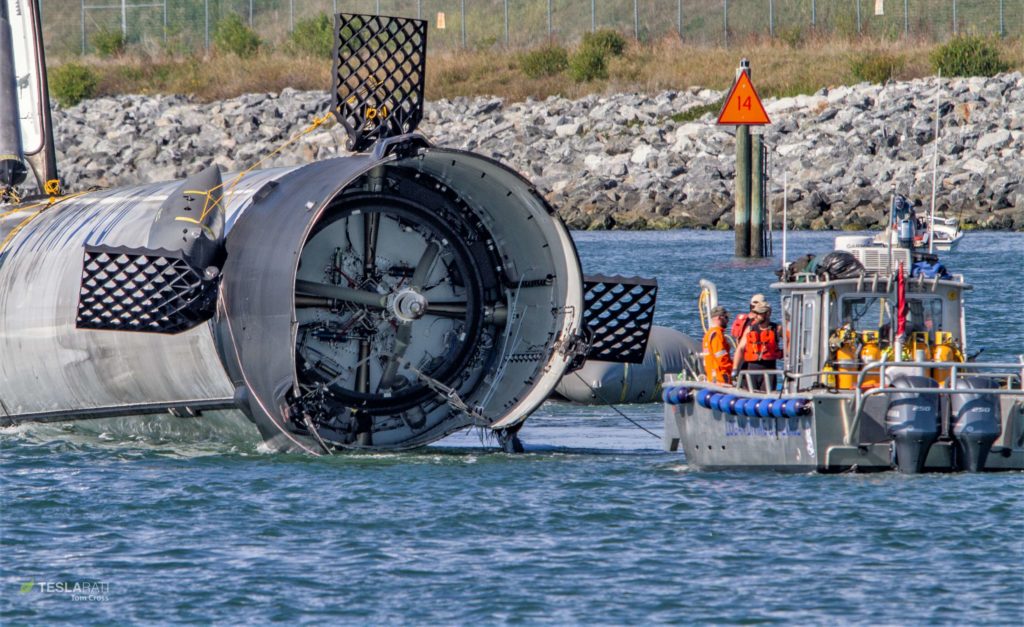
Meanwhile, beyond Super Heavy BN2’s first visible appearance, the process of assembling the first booster prototype also took a significant step forward. Sometime on January 19th, SpaceX ended a long period of inactivity, stacking the first Super Heavy ring sections since November 2020. More specifically, SpaceX teams appear to have installed either one or two four-ring sections on an existing booster segment already inside the high bay.
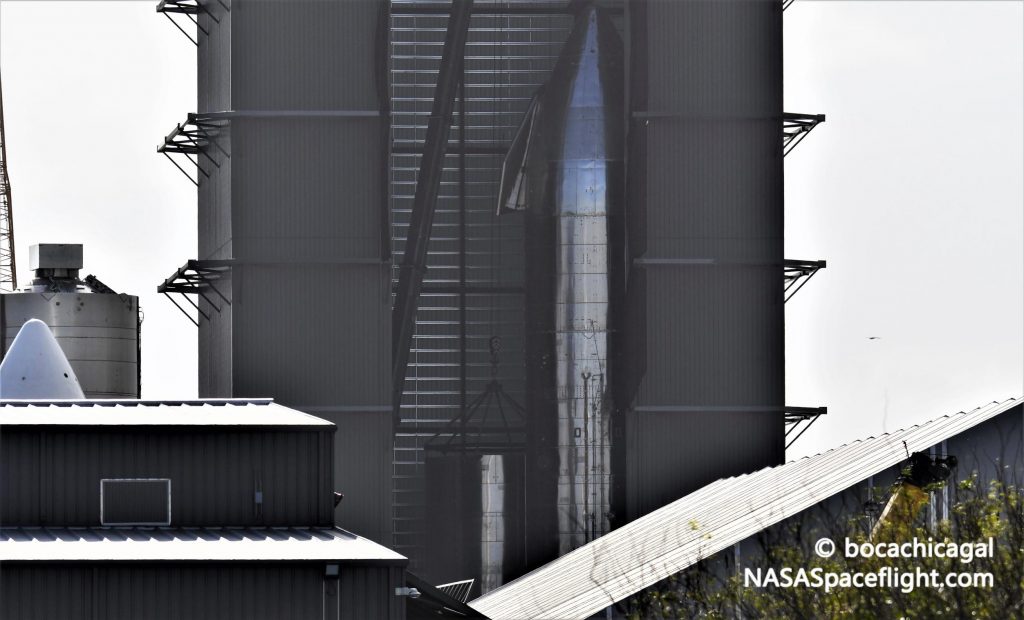
If at rest on top of the rest of the stack in Mary’s (BocaChicaGal) latest photo, one of two Super Heavy ‘stacks’ inside the high bay is now 12 rings (three sections) tall, representing almost a third of a complete 70-meter (~230 ft) tall booster. As of the most recent look inside the high bay, there were two separate stacks of Super Heavy rings – one with four and the other with eight. Based on the location of the new 12-ring stack, it’s more likely than not that SpaceX has simply combined the 12 rings last seen inside the high bay rather than adding one or two new ring sections to one of the two separate stacks.
Ultimately, the return of Super Heavy stacking activity after a two-month pause is an encouraging sign that SpaceX has settled on a design for the first few prototype boosters and could, in fact, be ready to start testing BN1 “a few months” from now.
News
Tesla begins Robotaxi certification push in Arizona: report
Tesla seems serious about expanding its Robotaxi service to several states in the coming months.

Tesla has initiated discussions with Arizona transportation regulators to certify its driverless Robotaxi service in the state, as per a recent report from Bloomberg News. The move follows Tesla’s launch of its Robotaxi pilot program in Austin, Texas, as well as CEO Elon Musk’s recent comments about the service’s expansion in the Bay Area.
The Arizona Department of Transportation confirmed to Bloomberg that Tesla has reached out to begin the certification process for autonomous ride-sharing operations in the state. While details remain limited, the outreach suggests that Tesla is serious about expanding its driverless Robotaxi service to several territories in the coming months.
The Arizona development comes as Tesla prepares to expand its service area in Austin this weekend, as per CEO Elon Musk in a post on X. Musk also stated that Tesla is targeting the San Francisco Bay Area as its next major market, with a potential launch “in a month or two,” pending regulatory approvals.
Tesla first launched its autonomous ride-hailing program on June 22 in Austin with a small fleet of Model Y vehicles, accompanied by a Tesla employee in the passenger seat to monitor safety. While still classified as a test, Musk has said the program will expand to about 1,000 vehicles in the coming months. Tesla will later upgrade its Robotaxi fleet with the Cyercab, a two-seater that is designed without a steering wheel.
Sightings of Cybercab castings around the Giga Texas complex suggests that Tesla may be ramping the initial trial production of the self-driving two-seater. Tesla, for its part, has noted in the past that volume production of the Cybercab is expected to start sometime next year.
In California, Tesla has already applied for a transportation charter-party carrier permit from the state’s Public Utilities Commission. The company is reportedly taking a phased approach to operating in California, with the Robotaxi service starting with pre-arranged rides for employees in vehicles with safety drivers.
News
Tesla sets November 6 date for 2025 Annual Shareholder Meeting
The automaker announced the date on Thursday in a Form 8-K.

Tesla has scheduled its 2025 annual shareholder meeting for November 6, addressing investor concerns that the company was nearing a legal deadline to hold the event.
The automaker announced the date on Thursday in a Form 8-K submitted to the United States Securities and Exchange Commission (SEC). The company also listed a new proposal submission deadline of July 31 for items to be included in the proxy statement.
Tesla’s announcement followed calls from a group of 27 shareholders, including the leaders of large public pension funds, which urged Tesla’s board to formally set the meeting date, as noted in a report from The Wall Street Journal.
The group noted that under Texas law, where Tesla is now incorporated, companies must hold annual meetings within 13 months of the last one if requested by shareholders. Tesla’s previous annual shareholder meeting was held on June 13, 2024, which placed the July 13 deadline in focus.
Tesla originally stated in its 2024 annual report that it would file its proxy statement by the end of April. However, an amended filing on April 30 indicated that the Board of Directors had not yet finalized a meeting date, at least at the time.
The April filing also confirmed that Tesla’s board had formed a special committee to evaluate certain matters related to CEO Elon Musk’s compensation plan. Musk’s CEO performance award remains at the center of a lengthy legal dispute in Delaware, Tesla’s former state of incorporation.
Due to the aftermath of Musk’s legal dispute about his compensation plan in Delaware, he has not been paid for his work at Tesla for several years. Musk, for his part, has noted that he is more concerned about his voting stake in Tesla than his actual salary.
At last year’s annual meeting, TSLA shareholders voted to reapprove Elon Musk’s compensation plan and ratified Tesla’s decision to relocate its legal domicile from Delaware to Texas.
Elon Musk
Grok coming to Tesla vehicles next week “at the latest:” Elon Musk
Grok’s rollout to Tesla vehicles is expected to begin next week at the latest.

Elon Musk announced on Thursday that Grok, the large language model developed by his startup xAI, will soon be available in Tesla vehicles. Grok’s rollout to Tesla vehicles is expected to begin next week at the latest, further deepening the ties between the two Elon Musk-led companies.
Tesla–xAI synergy
Musk confirmed the news on X shortly after livestreaming the release of Grok 4, xAI’s latest large language model. “Grok is coming to Tesla vehicles very soon. Next week at the latest,” Musk wrote in a post on social media platform X.
During the livestream, Musk and several members of the xAI team highlighted several upgrades to Grok 4’s voice capabilities and performance metrics, positioning the LLM as competitive with top-tier models from OpenAI and Google.
The in-vehicle integration of Grok marks a new chapter in Tesla’s AI development. While Tesla has long relied on in-house systems for autonomous driving and energy optimization, Grok’s integration would introduce conversational AI directly into its vehicles’ user experience. This integration could potentially improve customer interaction inside Tesla vehicles.
xAI and Tesla’s collaborative footprint
Grok’s upcoming rollout to Tesla vehicles adds to a growing business relationship between Tesla and xAI. Earlier this year, Tesla disclosed that it generated $198.3 million in revenue from commercial, consulting, and support agreements with xAI, as noted in a report from Bloomberg News. A large portion of that amount, however, came from the sale of Megapack energy storage systems to the artificial intelligence startup.
In July 2023, Musk polled X users about whether Tesla should invest $5 billion in xAI. While no formal investment has been made so far, 68% of poll participants voted yes, and Musk has since stated that the idea would be discussed with Tesla’s board.
-

 Elon Musk1 week ago
Elon Musk1 week agoTesla investors will be shocked by Jim Cramer’s latest assessment
-

 Elon Musk18 hours ago
Elon Musk18 hours agoxAI launches Grok 4 with new $300/month SuperGrok Heavy subscription
-

 Elon Musk3 days ago
Elon Musk3 days agoElon Musk confirms Grok 4 launch on July 9 with livestream event
-

 News7 days ago
News7 days agoTesla Model 3 ranks as the safest new car in Europe for 2025, per Euro NCAP tests
-

 Elon Musk2 weeks ago
Elon Musk2 weeks agoA Tesla just delivered itself to a customer autonomously, Elon Musk confirms
-

 Elon Musk1 week ago
Elon Musk1 week agoxAI’s Memphis data center receives air permit despite community criticism
-

 Elon Musk2 weeks ago
Elon Musk2 weeks agoTesla’s Omead Afshar, known as Elon Musk’s right-hand man, leaves company: reports
-

 News2 weeks ago
News2 weeks agoXiaomi CEO congratulates Tesla on first FSD delivery: “We have to continue learning!”

















